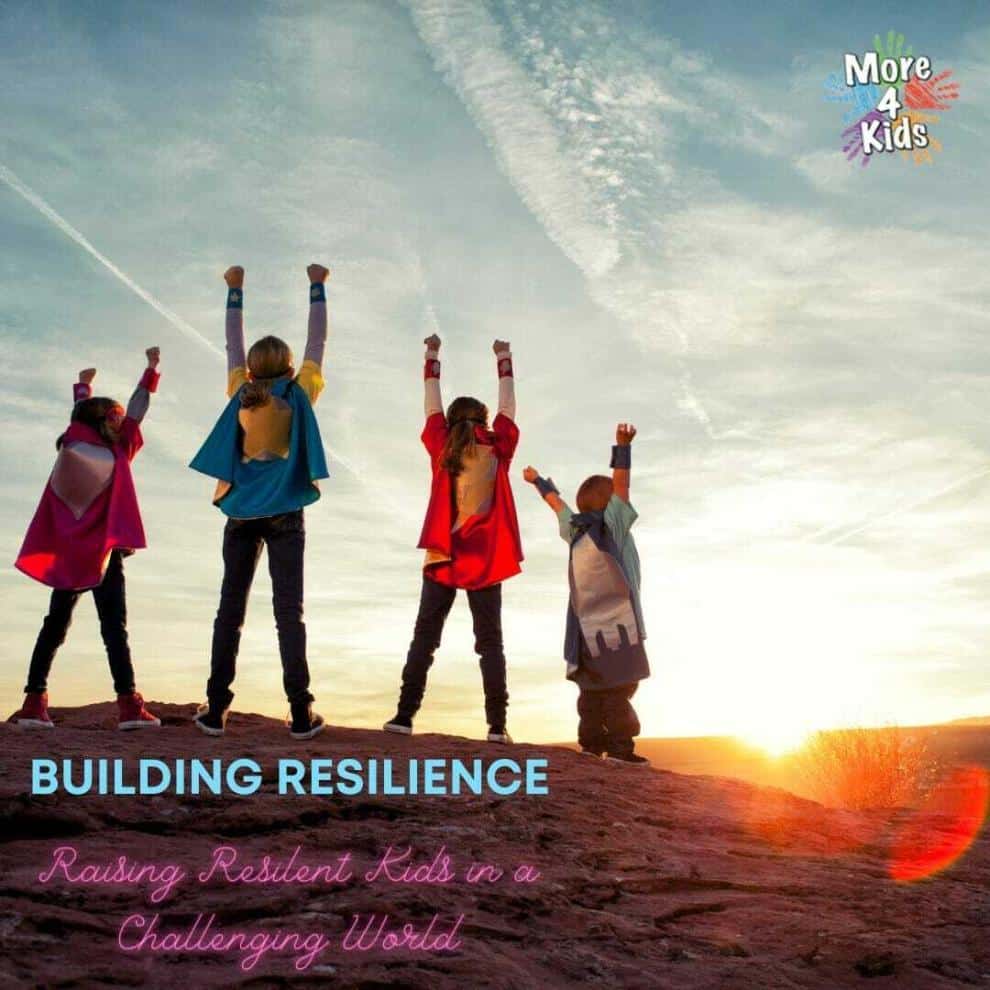Resilience is the ability to cope with stress, adversity, and change. It is a skill that can help children overcome challenges, bounce back from setbacks, and grow from failures. Resilience is not something that children are born with or without; it is something that can be learned and developed through nurturing and supportive relationships, positive experiences, and effective coping strategies.
As parents, we want our children to be happy and successful, but we also know that life is full of uncertainties and difficulties. We cannot protect our children from every hardship or disappointment, but we can help them develop the resilience they need to face them with confidence and optimism. Here are some tips on how to raise a resilient and successful child in a challenging world:
Provide a safe and supportive environment.
Table of Contents
Providing a safe and supportive environment is one of the most important things you can do as a parent to help your child develop resilience. A safe and supportive environment means that your child feels loved, accepted, and valued by you and other caregivers. It also means that your child has a sense of belonging and security in your family and community. You can provide a safe and supportive environment by:
– Showing your child unconditional love and affection. Tell your child that you love them every day, and express your love through hugs, kisses, and cuddles. Praise your child for their efforts and achievements, and acknowledge their feelings and opinions. Listen to your child attentively, and respect their individuality and preferences.
– Creating a positive and nurturing atmosphere at home. Make your home a place where your child feels comfortable and happy. Keep your home clean and organized, and provide your child with a cozy and personal space. Establish a regular and consistent routine for your child, and involve them in household chores and activities. Have fun and laugh with your child, and share quality time together.
– Setting clear and consistent boundaries, rules, and expectations. Help your child feel safe and secure by providing them with structure and guidance. Set reasonable and age-appropriate limits for your child, and explain the reasons and consequences of your rules. Be firm and consistent in enforcing your rules, and use positive reinforcement and natural consequences to encourage good behavior. Avoid harsh or abusive discipline, and model respectful and polite communication.
– Supporting your child’s social and emotional development. Help your child build healthy and positive relationships with others. Encourage your child to make friends, join clubs, and participate in community events. Teach your child social skills, such as sharing, taking turns, cooperating, and resolving conflicts. Help your child cope with peer pressure, bullying, and rejection. Monitor your child’s online and offline interactions, and protect them from harmful influences and situations.
Encourage positive emotions and optimism
Encouraging positive emotions and optimism is another way to help your child develop resilience. Positive emotions and optimism mean that your child experiences joy, gratitude, hope, and humor in their lives. It also means that your child looks at the bright side of things, and expects positive outcomes. Positive emotions and optimism can help your child cope with stress, reduce anxiety and depression, and enhance well-being and happiness. You can encourage positive emotions and optimism by:
– Helping your child find and pursue their passions and interests. Support your child’s hobbies, talents, and dreams, and provide them with opportunities and resources to explore and develop them. Celebrate your child’s achievements and milestones, and help them overcome challenges and setbacks. Help your child discover their strengths and values, and encourage them to use them for good causes.
– Teaching your child to appreciate the good things in life, even in difficult times. Help your child practice gratitude, and express your own gratitude for your child and other things. Help your child notice and appreciate the beauty and wonder of nature, art, music, and other sources of joy. Help your child develop a positive attitude towards themselves, others, and the world, and avoid negative self-talk, criticism, and complaints.
– Helping your child develop a positive and realistic outlook on the future. Help your child set realistic and attainable goals, and break them down into manageable steps. Help your child plan and prepare for possible challenges and obstacles, and brainstorm solutions and alternatives. Help your child visualize and anticipate positive outcomes, and avoid catastrophizing or exaggerating negative scenarios. Help your child learn from the past, live in the present, and look forward to the future.
– Helping your child have fun and laugh more. Make your child smile and laugh every day, and share jokes, stories, and funny videos with them. Play games, watch movies, and do other fun activities with your child, and encourage them to have fun with their friends and family. Help your child develop a sense of humor, and teach them how to laugh at themselves and their mistakes. Help your child see the funny and absurd side of life, and not take things too seriously.
Model and teach coping skills
Modeling and teaching coping skills is another way to help your child develop resilience. Coping skills mean that your child knows how to manage their emotions, thoughts, and behaviors in healthy and constructive ways. It also means that your child knows how to cope with failure, rejection, and criticism, and to see them as opportunities for learning and growth. Coping skills can help your child deal with challenges, overcome obstacles, and achieve their goals. You can model and teach coping skills by:
– Showing your child how you cope with stress, adversity, and change. Share your own feelings, thoughts, and actions when you face difficulties or disappointments. Show your child how you calm yourself down, express your emotions, solve problems, and seek help when needed. Show your child how you cope with failure, rejection, and criticism, and how you learn and improve from them. Show your child how you cope with uncertainty and ambiguity, and how you adapt and adjust to new situations.
– Helping your child identify and regulate their emotions. Help your child recognize and name their emotions, and understand their causes and effects. Help your child learn and practice relaxation techniques, such as deep breathing, meditation, yoga, or music. Help your child learn and practice positive self-talk, affirmations, or mantras. Help your child learn and practice healthy ways to express their emotions, such as talking, writing, drawing, or playing.
– Helping your child develop and apply problem-solving skills. Help your child define and understand the problem, and identify the goal and the obstacles. Help your child generate and evaluate possible solutions, and choose the best one. Help your child implement and monitor the solution, and revise it if needed. Help your child reflect and learn from the problem-solving process, and celebrate the outcome.
– Helping your child seek and accept help when needed. Help your child recognize when they need help, and how to ask for it. Help your child identify and access the available sources of help, such as parents, teachers, friends, counselors, or online resources. Help your child appreciate and acknowledge the help they receive, and reciprocate it when possible. Help your child overcome the fear or shame of asking for help, and see it as a sign of strength and courage.
Promote a growth mindset
Promoting a growth mindset is another way to help your child develop resilience. A growth mindset means that your child believes that they can learn, improve, and succeed through their own efforts and strategies. It also means that your child understands that intelligence, abilities, and talents are not fixed, but can be developed and enhanced through hard work, practice, and feedback. It also means that your child embraces challenges, learns from mistakes, and celebrates progress and achievements. A growth mindset can help your child develop a positive attitude towards learning, a sense of competence and self-efficacy, and a motivation to persevere and excel. You can promote a growth mindset by:
– Praising your child’s effort, process, and strategy, not their ability, talent, or outcome. Help your child focus on the things they can control, such as their effort, attitude, and behavior, rather than the things they cannot, such as their ability, talent, or outcome. Praise your child for trying hard, using effective strategies, and overcoming challenges, rather than for being smart, talented, or successful. Avoid labels, such as “smart”, “dumb”, “gifted”, or “lazy”, that imply fixed traits or abilities.
– Encouraging your child to take on challenges and learn new things. Help your child see challenges as opportunities to learn and grow, rather than as threats or obstacles. Help your child choose tasks and activities that are slightly above their current level of skill or knowledge, and that require effort and persistence. Help your child avoid tasks and activities that are too easy or too hard, and that do not challenge or stimulate them. Help your child see learning as a lifelong and enjoyable process, rather than as a finite and stressful one.
– Helping your child learn from feedback and mistakes. Help your child see feedback and mistakes as sources of information and guidance, rather than as signs of failure or criticism. Help your child seek and accept constructive feedback from others, and use it to improve their performance and understanding. Help your child analyze and learn from their own mistakes, and use them to correct and refine their strategies and skills. Help your child avoid blaming others or making excuses for their mistakes, and take responsibility and ownership for their learning and improvement.
– Celebrating your child’s progress and achievements. Help your child set realistic and attainable goals, and break them down into manageable steps. Help your child monitor and track their progress and improvement, and recognize and appreciate their efforts and accomplishments. Help your child compare their performance and understanding to their own past performance and understanding, rather than to others’ performance and understanding. Help your child celebrate their achievements and milestones, and reward them with praise, recognition, or incentives.
Foster a sense of purpose and meaning
Fostering a sense of purpose and meaning is another way to help your child develop resilience. A sense of purpose and meaning means that your child has a clear and compelling reason to live, learn, and grow. It also means that your child has a vision and a direction for their future, and that they feel connected and aligned with their values and passions. It also means that your child contributes to something larger and more important than themselves, and that they make a positive difference in the world. A sense of purpose and meaning can help your child develop a sense of identity, belonging, and fulfillment, and a motivation to pursue their goals and dreams. You can foster a sense of purpose and meaning by:
– Helping your child discover and explore their interests, passions, and talents. Help your child identify and pursue the things that they enjoy, excel at, and care about. Help your child find and join activities, clubs, or organizations that match their interests, passions, and talents. Help your child develop and showcase their skills, abilities, and gifts, and appreciate their uniqueness and potential.
– Helping your child develop and articulate their values and beliefs. Help your child reflect on and express their values and beliefs, and how they shape their choices and actions. Help your child understand and respect the values and beliefs of others, and how they differ from or overlap with their own. Help your child align their values and beliefs with their goals and aspirations, and how they can achieve them.
– Helping your child find and create meaning in their experiences and relationships. Help your child reflect on and share their experiences and relationships, and how they affect and influence them. Help your child find and create meaning in their experiences and relationships, and how they relate to their purpose and goals. Help your child appreciate and celebrate the positive and meaningful aspects of their experiences and relationships, and cope with and learn from the negative and challenging ones.
– Helping your child engage in service and social action. Help your child identify and address the needs and problems of their community and the world, and how they can help and solve them. Help your child engage in service and social action, such as volunteering, fundraising, campaigning, or mentoring. Help your child understand and appreciate the impact and benefits of their service and social action, and how they align with their purpose and values. Help your child develop a sense of responsibility, compassion, and citizenship, and a desire to make the world a better place.
Raising a resilient child may not an easy task, but it is one of the most rewarding and important things we can do as parents. By providing a safe and supportive environment, encouraging positive emotions and optimism, modeling and teaching coping skills, promoting a growth mindset, and fostering a sense of purpose and meaning, we can help our children develop the resilience they need to thrive in a challenging world.













Add Comment